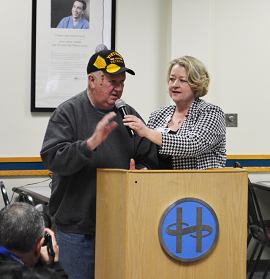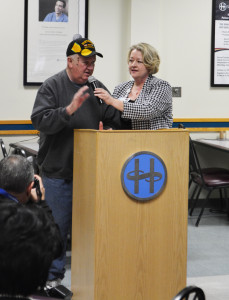
So, what do you do when you realize care is not as efficient and easy as it could be for a person seeking your help with a medical problem? You consider process redesign.
That is exactly as it was for some of our patients with Chronic Obstructive Pulmonary Disease (COPD). There did not seem to be a coordinated process and our COPD patients often found themselves in our Emergency Department and back in our hospital. We came to understand the toll this cycle takes on a person’s quality of life.

Mr. Howard Cullinan was one of our program participants. He is show here with Holly Thompson, the COPD coordinator for our Homeward Bound program, speaking at an event about what participation in the program has meant to him.
So what did we do? We redesigned the process.
We brought together many members of the care team from all disciplines that worked with our COPD patients to design a program — a new patient experience. Everyone’s task was to figure out what were the “best practice” elements of their discipline for this population.
We felt that if we had caregivers that provided best practice activities to our patients, the overall experience would not only be of high quality but could add a sense of satisfaction and well-being. As each discipline designed their part of the COPD care process with “best practice” elements, the individual changes were piloted.
In patient interviews, we learned patients did not often know much about COPD or how their medicines helped the lung disease. Education is regularly provided but it did not seem to have the impact it needed to create habit change. Sometimes patients felt they received no benefit from the medications. So, we knew the program would have to include patient education on disease process and the benefit of using the medications, in a way that made the learning stick.
Building the team
The COPD PATHWAYS team included the voice of the patient through our interviews as well as representatives from case management leadership, a physician leader, the manager of our Hospitalist Medicine group, respiratory therapy colleagues, the director of Nursing Quality, a clinical pharmacist, a pulmonary rehabilitation specialist, a nutritionist, our process improvement Lean specialist and representation of our home care colleagues. For home care, we are partnered with our local visiting nurses association and with students and faculty from our school of nursing and local college nursing students and faculty who participate in a program called Homeward Bound.
The goals of the program were to enhance the patient’s quality of life, to reduce potential negative outcomes through education and understanding of the disease process, and through that education, empower the patient to a have an improved level of self-care management.
Arming patients with the right tools
The COPD PATHWAYS team developed patient educational tools that are easily understood by all age groups. To achieve this, the materials were vetted through the staff education department to assess reading level of the materials.
The team actively teaches the COPD patient the early warning signs of an exacerbation.The patient uses an action plan to evaluate and document their clinical symptoms each day. The action plan has three categories that assist the patient in recognizing worsening symptoms from their baseline. There are actions associated with each level of difficulty. These materials are reviewed with the patient during the hospital stay.
We used the “Teach-Back” method to determine the patient’s grasp of the education. This is documented on a care map that is shared by all team members and left at the patient’s bedside. The patient takes these materials home to help with self-care and is encouraged to review the established action plan and the data collected during scheduled follow-up appointments with his or her primary care physician (PCP).
We have learned the key to success is in the relationship that is built with the patient. Nursing and case management begin this important task. Through the hospital stay, they provide support and guidance. After discharge, there is a high level of engagement with the patients by the care manager and the clinical pharmacists. Robust medication reconciliation is done–even with the medications in the home. The care manager coordinates the clinical activity, regularly checks in with the partners providing home care, determines if any barriers exist to attending the PCP follow-up appointment and after approximately three weeks transitions the patient to the case managers in the outpatient practices.
Growing pains
Our largest cultural discomfort was that the implementation of this new program caused many different providers to visit the COPD PATHWAYS patients during their hospital stay. For the primary nurse of these patients, this created a situation where the patient often was engaged with another team member for much of the day. It was no longer a restful environment. It became a teaching environment. The objective had changed to teaching the patient as much as possible during the limited time of the hospital stay. This created a conflict for some of the care providers and sometimes for the patients themselves.
To address this, we provided more widespread education for our nursing staff to help them understand the goals and elements of the program. Within a short time, as our patients began to have a better sense of disease process and how to manage their COPD, they helped message the usefulness and provide the confidence in this intense teaching approach.
Results show engagement boosts outcomes
The program has been in existence for 12 months and there have been improvements in admission and readmission numbers for our COPD patients. We have received wonderful feedback and many praises from patients and their families. Program participants have gone back to work, returned to using the gym regularly, and some even celebrated with their Homeward Bound nursing students at the graduation of the new nurse.
Editor’s Note: Signature Healthcare Brockton Hospital was a John Q. Sherman Award Finalist. You can learn more about their work in their 2016 award nomination.





